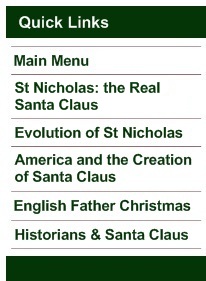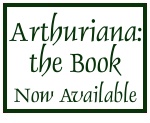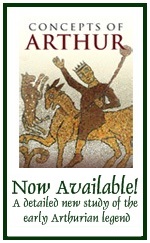
 |
 |
Historians, Folklorists and Other Critics on Santa Claus The Origins of Santa Claus in England From J. Simpson and S. Roud, The Oxford Dictionary of English Folklore (Oxford, 2001), p. 314 This American name for the Christmas gift-bringer is increasingly used in England, generally in the shortened form ‘Santa’. Early American settlers, being Puritans, rejected the English Father Christmas, but later Dutch immigrants brought traditions about St Nicholas, popularized through a poem by Clement Clark Moore, ‘The Visit of Saint Nicholas’ (1822), now more usually called ‘The Night Before Christmas’. Moore describes the saint not as a bishop in a red cope, as in Holland, but as a fat man dressed in fur, driving a reindeer sleigh. He may well have been aware that in many European traditions, notably in Germany, St Nicholas is accompanied by fur-clad or gnome-like servants who carry presents for good children, but a birch for bad ones; such images might seem more appealing than a saint in religious garb. Illustrating Moore's poem in the 1860s, Thomas Nast used the colloquial Dutch ‘Santa Claus’ rather than the formal ‘St Nicholas’, and dressed him in a belted jacket and furry cap. During the rest of the 19th century, Santa was often shown in a red jacket but with blue knickerbockers, as befits a Dutchman; in the 20th century, an all-red outfit with white trimmings became the norm, especially after a Coca-Cola advertising campaign exploited his figure in 1931. The artist, the Swede Haddon Sundblom, also gave him a drooping tassled red cap like those associated with elves and gnomes; he may have been thinking of a Swedish Christmas gnome. Scandinavian influence also accounts for the elfin assistants often mentioned, and the home at the North Pole. Rudolph the Red-Nosed Reindeer dates from 1949, in a song by Johnny Marks. The name apparently reached England in the 1870s, to the puzzlement of observers, though the hanging-up of stockings was already an ‘old’ custom, at any rate in the northern countries (Henderson, 1866: 50). The first mention of the gift-bringer's name which we have traced is a letter to N&Q (5s:11 (1879), 66), where a Mr Edwin Lees says he has ‘only lately been told’ of a custom currently observed in Herefordshire, Worcestershire, and Devonshire, which he has not seen recorded anywhere:
William Brockie noticed the same custom round Durham in the 1880s; he too was puzzled by the unfamiliar name and made the ingenious but mistaken guess that it was ‘Santa Cruz, the Holy Cross’ which brought the presents (Brockie, 1886: 92-3). By what channels this American feature reached Victorian England is at present unknown. One possibility (proposed anonymously in The Times of 22 December 1956) is a popular American story, The Christmas Stocking by Susan Warner, printed in London in 1854 and several times thereafter. Santa Claus and Thor From L. Woodbridge, 'Black and White and Red All Over: The Sonnet Mistress Amongst the Ndembu', in Renaissance Quarterly, 40.2 (1987), pp. 247-97 at pp. 274-5 Moore did not create Santa but "crystalized popular notions of the visit of the gift bringer" (Barnett 27), and in doing so he took over the ritual colours, probably from the Dutch, whose St Nicholas (like Moore's) comes down the chimney, a descent primarily responsible for the white and black in his color scheme: "His clothes were all tarnished with ashes and soot." Soot is an inevitable symbolic substance, completing a triad, in its blackness, with the red of fire and the white of ash: one thinks of blackened chimney sweeps in May ceremonies, and of the many blacked faces in folk festivities. The chimney descent supports the theory that Santa is ultimately the Norse god Thor:[fn9 - The Norse god Odin, who rode a white horse or drove reindeer, may also have contributed to the Santa Claus legend] as Francis Weiser points out, Thor was represented with a long white beard; his colour was red, since his element was fire, into which he descended through chimneys. His chariot was drawn by two white goats. He became the Yule-god through battling against the giants of ice and snow; he lived in the northland among icebergs (113). Moore's St. Nick is a fire-spirit at least in his pipe-smoking: "The smoke it encircled his head like a wreath." Professor of Hebrew and Oriental languages at a theological college (Pimlott 115), Moore had the education to be aware of mythic antecedents of the Christmas figure he assembled. Santa's debt to Thor was spotted as early as 1872, when O. M. Spencer placed both figures in the context of seasonal fertility rite: Thor battling the ice-giant is Spring's eternal conflict with Winter. The three ritual colors attached to St. Nicholas since the Middle Ages are appropriate to a figure rooted in the seasonal fertility rite. *
* * * *
Copyright ©
2008, 2009 Caitlin R. Green. All Rights Reserved. To cite articles or pages
from
this website, use a service such as WebCite or
alternatively see one of the following style
citation guides. Comments and queries via email to Caitlin R. Green |
 
|